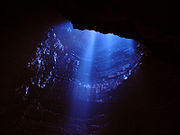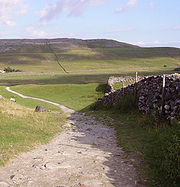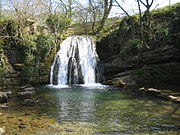
Yorkshire Dales
Did you know...
SOS Children made this Wikipedia selection alongside other schools resources. Sponsor a child to make a real difference.
| Yorkshire Dales | |
| Protected Area | |
|
National park entrance sign, near Skipton
|
|
| Country | United Kingdom |
|---|---|
| Part | England |
| Counties | North Yorkshire, Cumbria |
| Area | 1,769 km2 (683 sq mi) |
| National Park of England | 1954 |
| IUCN category | II - National Park |
The Yorkshire Dales (also known as "The Dales") is the name given to an upland area, in Northern England.
The area lies within the historic county boundaries of Yorkshire, though it spans the ceremonial counties of North Yorkshire, West Yorkshire, and Cumbria. Most of the area falls within the Yorkshire Dales District National Park, created in 1954, and now one of the twelve National parks of England and Wales (not including the South Downs which is due to become one).
The Dales is a collection of river valleys and the hills in between them, rising from the Vale of York westwards to the hilltops of the main Pennine watershed (the British English meaning). In some places the area even extends westwards across the watershed, but most of the valleys drain eastwards to the Vale of York—into the Ouse and then the Humber.
"Dale" comes from a Nordic/Germanic word for valley, and occurs in valley names across Yorkshire (and northern England generally) but since the creation of the Yorkshire Dales National park, the name "Yorkshire Dales" has come to refer specifically to these western dales (the area of dales and hills EAST of the Vale of York is now always called the " North York Moors" after the National Park created there). Confusingly, the Yorkshire Dales have plenty of moors, too.
They tend to be Glacial.
Geography
Most of the dales in the Yorkshire Dales are named after their river or stream (eg Arkengarthdale, formed by Arkle Beck). The best-known exception to this rule is Wensleydale, which is named after the town of Wensley rather than the River Ure, although an older name for the dale is Yoredale. In fact, valleys all over Yorkshire are called "(name of river)+ dale"—but only the more northern Yorkshire valleys (and only the upper, rural, reaches) are included in the term "The Dales". For example, the southern boundary area lies in Wharfedale and Airedale. The lower reaches of these valleys are not usually included in the area, and Calderdale much further south, would never normally be referred to as part of "The Dales" even though it is a dale, is in Yorkshire, and the upper reaches are as scenic and rural as many valleys further north.
Geographically, the classical Yorkshire Dales spread to the north from the market and spa towns of Settle, Deepdale near Dent, Skipton, Ilkley and Harrogate in North Yorkshire, with most of the larger southern dales (e.g. Ribblesdale, Malhamdale and Airedale, Wharfedale and Nidderdale) running roughly parallel from north to south. The more northerly dales (e.g. Wensleydale, Swaledale and Teesdale) running generally from west to east. There are also many other smaller or lesser known dales (e.g. Arkengarthdale, Barbondale, Bishopdale, Clapdale, Coverdale, Dentdale and Deepdale, Garsdale, Kingsdale, Littondale, Langstrothdale, Raydale, Waldendale and the Washburn Valley) whose tributary streams and rivers feed into the larger valleys.
The characteristic scenery of the "Dales" is green upland pastures separated by dry-stone walls and grazed by sheep and cattle. The dales themselves are 'U' and 'V' shaped valleys, which were enlarged and shaped by glaciers, mainly in the most recent, Devensian ice age. The underlying rock is principally Carboniferous limestone (which results in a number of areas of limestone pavement) in places interspersed with shale and sandstone and topped with millstone grit. However, to the north of the Dent fault, the hills are principally older Silurian and Ordovician rocks, which make up the Howgill Fells.
Many of the upland areas consist of heather moorland, used for grouse shooting in the months following August 12 each year (the ' Glorious Twelfth').
Cave systems
Because of the limestone that runs throughout the "Dales" there are extensive cave systems present across the area making it one of the major areas for caving in the UK. Many of these are open to the public for tours and for caving.
These include:
- Gaping Gill System,
- Alum Pot System
- Mossdale Caverns
- Kingsdale Caverns
- Leck Fell Caves
- Easegill System
- White Scar Caves near Ingleton,
- Ingleborough Cave in Clapdale near Clapham,
- Stump Cross Caverns near Pateley Bridge.
Yorkshire Dales National Park
In 1954 an area of 1,770 km² was designated the Yorkshire Dales National Park. Most of the National Park is in North Yorkshire, though part lies within Cumbria. The park is 50 miles (80 km) north east of Manchester; Leeds and Bradford lie to the south, while Kendal is to the west and Darlington to the east.
Over 20,000 residents live and work in the park, which attracts over eight million visitors every year. The area has a large collection of activities for visitors. For example, many people come to the "Dales" for walking or exercise. The National Park is crossed by several long-distance routes including the Pennine Way, the Dales Way, the Coast to Coast Path and the latest national trail - the Pennine Bridleway. Cycling is also popular and there are several cycleways.
The Park has its own museum, the Dales Countryside Museum, housed in a conversion of the Hawes railway station in Wensleydale in the north of the Park. The park has 5 visitor centres located in major destinations in the park. These are at:
- Aysgarth Falls
- Grassington
- Hawes
- Malham
- Reeth
Other places and sights within the National Park include:
- Bolton Castle
- Clapham
- Cautley Spout waterfall
- Gaping Gill
- Hardraw Force
- Horton in Ribblesdale
- Kisdon Force waterfall in Swaledale
- Malham Cove and Gordale Scar
- Sedbergh
- Settle
- Settle and Carlisle Railway including the Ribblehead Viaduct
- Skipton
- The Yorkshire three peaks
List of Dales
- Arkengarthdale
- Birkdale
- Bishopdale
- Coverdale
- Dentdale
- Garsdale
- Langstrothdale
- Littondale
- Malhamdale
- Nidderdale
- Ribblesdale
- Swaledale
- Wensleydale
- Wharfedale







